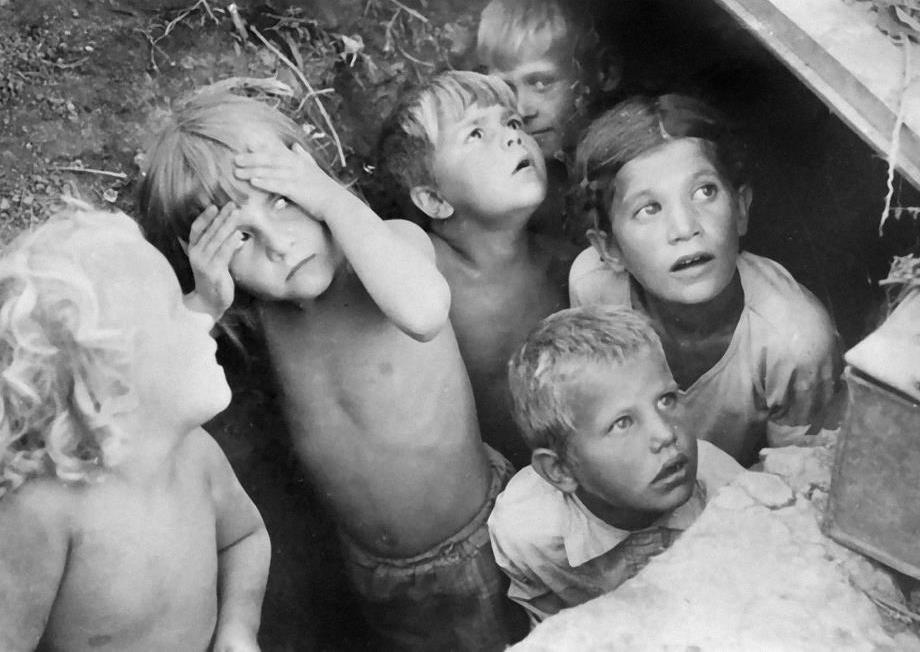
World War II Air War: Stalingrd--Reducing the City to Rubble (August-November 1942)

Figure 1.--As the Panzers approached Stalingrad, the Luftwffe began aassive bombadment which essentially destroyed the city. Stalin refused to evacuate the children. There were no bomb shelters. Here children take shelter in a trench, robably on August 23. Source: State Archive of Volgograd (modern name for Stalingrad) Region.
|
|
As the German Panzers approached the suburbs of Salingrad (August 23), Luftflotte 4 commenced to bomb the city. The Luftwafe was a finally honed tatical airforce, playing a key role in the German victories, both in the West and then with Barbarossa in the East. The Germans had begun the War in Poland with close air support. It tookthe Allies over 3 years to adopt a similar tactical doctrine. Confronted with this vast Soviet industrial city, the Germans deided to reduceit o rubble. We are not sure who gave this order or to what extent the most effective role of the Luftwaffe was actually assessed by German commanders. What we do know at this time is what the Germans did. They proceeded to reduce the city to rubble.
This appears to have been an instivtive German military decision which little thought given a to how to use the available ir power. Luftflotte 4 began pounded the city in the morning and continued into the day. The Luftwaffe did not hav a strategic bombing force. They used their medium bombers, elements of KG 27, KG 51, KG 55, KG 76, and I/KG 100. [Bergstrom, p. 72.] Luftflotte 4 flew some 1,600 sorties and dropped 1,000 tons of bombs on the city essentilly destrong it (Aigust 23). Only three aircraft were lost that first day. The destruction resulted not only fom the bombs, but from the fores tht broke out all over the city. The headquarters of the city's air defences were bombed, adversely affecting the air defenses. Alhough the ity wleft a vast ple of rubble, some of the larger factories while damaged incredibly continued to function. Worker militias defended their factories. fighting. The Germans continued bomb the city block-by-block for another 5 days. The Soviets cliam that fighter defences of 8 VA and 102 IAD PVO shot down 90 German planes and that anti-aircraft unts shot down another 30 German planes.
The Red Air Force in the Stalingrad area lost over 200 aircraft (August 23–31). Some limited replacemnts arrived, but beginning in setember the burden of air defense fell to the 1077th Anti-Aircraft (AA) Regiment. Stalin had refused to evacuate civiians. This may have beensue to the importance of the city's industrarial output. Historians also cite his belief thatthe soldiers would fight more resolutely with civilians in the city. Whatever the reason, the city's civiians paid a heavy price. It is estimated that some 90,000 civilians were killed in the bombing amid the rubble. [Prikazchikova]
The question becomes what was the impact of the bombing. Wars are not won by killing civilians or destroying buildings. This should have been thelesson learned in theBattle of Britain, but clearly was not. As far as we can tell, the Luftwaffe commanders just assumed that leveling the city would help the ground units take the city.
The rubble created impeded the mobility of the German panzers. It also create infanite firing positions for the Russian infantry defending the city. The Wehrmacht's strength was its mobility. The Red Army's strength was the tenacious resistance of the individual soldier. Turning the city into a sea of rubble played into the Soviet strength. Over the entire campaign before the Soviet encirclemnt, Luflotte 4 flew 70,000 sorties dropping more than a million bombs. After the first few days, many of the bombs dropped only stirred up the rubble. The Sovietssoon realized that it was to their advantage to position themselves as closeas possible to the German lines, making it difficult for the Luftwaffe to bomb them out of fear of hitting their own men.
Sources
Bergstrom, Christer. Stalingrad: The Air Battle 1942 Through January 1943.
Prikazchikova, Tatyana. Senior research fellow at the Stalingrad Memorial. She places the death toll in the first few dys of the bombing at 93,000 people..
CIH -- WW II

Navigate the CIH World War II Section:
[Return to Main Stalingrad air page]
[Return to Main Stalingrad page]
[Return to Main World war II air war page]
[Return to Main World War II campaign page]
[About Us]
[Aftermath]
[Biographies]
[Campaigns]
[Children]
[Countries]
[Deciding factors]
[Diplomacy]
[Geo-political crisis]
[Economics]
[Home front]
[Intelligence]
[POWs]
[Resistance]
[Race]
[Refugees]
[Technology]
[Totalitarian powers]
[Bibliographies]
[Contributions]
[FAQs]
[Images]
[Links]
[Registration]
[Tools]
[Return to Main World War II page]
[Return to Main war essay page]
[Return to CIH Home page]
Created: 8:56 AM 5/8/2016
Last updated: 8:56 AM 5/8/2016



